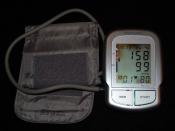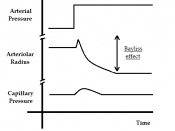Introduction:Blood pressure is the pressure exerted by the blood on the walls of the blood vessels. Blood pressure is understood to mean arterial blood pressure, and also the pressure in the large arteries, such as the brachial artery in the arm. The pressure of the blood in other vessels is lower than the arterial pressure. Blood pressure values are universally stated in millimeters of mercury (mm Hg), and are always given relative to atmospheric pressure-the absolute pressure of the blood in an artery with mean arterial pressure stated as 100 mm by a day with atmospheric pressure of 760 mm, is 860 mm (Jarvis, 3).
The systolic pressure is defined as the peak pressure in the arteries during the cardiac cycle; the diastolic pressure is the lowest pressure is at the resting phase of the cardiac cycle. The mean arterial pressure and pulse pressure are other important quantities (AHA, 1).
Typical values for a resting, healthy adult are approximately 120 mmHg systolic and 80 mmHg diastolic written as 120/80 mmHg; however, this can vary with large individuals. These measures of blood pressure are not static, but undergo natural variations from one heartbeat to another or throughout the day in a circadian rhythm; they also change in response to stress, nutritional factors, drugs, or disease, such as Parkinson's disease and Diabetes (2).
The auscultatory method uses a stethoscope and a sphygmomanometer. This comprises an inflatable cuff placed around the upper arm at roughly the same vertical height as the heart, attached to a mercury or aneroid manometer. The cuff is inflated manually by repeatedly squeezing a rubber bulb until the artery is completely occluded. Listening with the stethoscope to the brachial artery at the elbow, the examiner slowly releases the pressure in the cuff. When blood just starts to flow...


